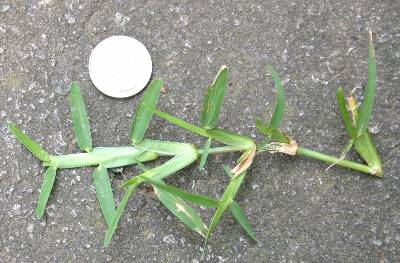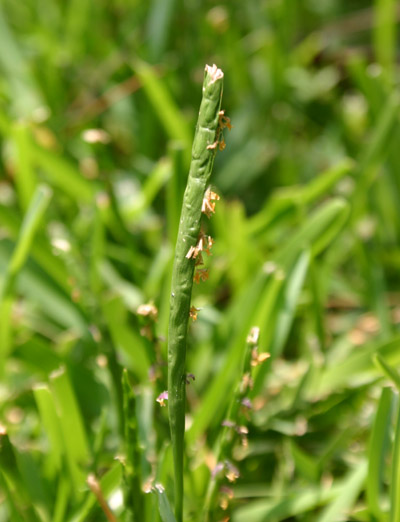





Information taken from
The Revised Georgia Gardener’s Guide
Walter Reeves and Erica Glasener
Where would south Georgia lawns be without St. Augustine grass? St. Augustine grass is an excellent choice for the sandy soils of the lower half of the state. St. Augustine is not unusual from Macon up to Atlanta, though it is not the predominant turfgrass choice. North of Atlanta, only lawn gamblers plant a grass that will suffer cold injury in most winters. Although St. Augustine grass is less cold tolerant than other warm-season turfgrasses, it stays green longer in the fall. It is not unusual for it to still be green in the middle of winter in protected areas or under fallen tree leaves. St. Augustine grass is very tolerant of shade. The wide leaves are efficient in gathering sunshine underneath shrubs and trees. It is also an excellent full-sun turf and will crowd out most weeds.
Color and Texture
Emerald green, winter dormant. More coarsely textured than bermudagrass. It grows so aggressively that a lawn feels slightly spongy beneath your feet.
Recommended Mowing Height
2 inches to 3 inches
Light Requirements
Full sun, part sun
When, Where, and How to Plant
Seed is unavailable. Plant St. Augustine sod or plugs any time from late spring through early fall. Sod is easy to lay. Simply clear the area of weeds, dig the soil with a tiller, and rake it smooth. Using a hatchet to cut smooth curves around landscape islands and concrete curbs, place the pieces in a pattern like a bricklayer’s. St. Augustine grass grows very rapidly. You can plant 3 inch by 3 inch plugs 12 inches apart in spring and they will grow together by fall. Plant the plugs in an existing sunny lawn and the St. Augustine grass will eventually crowd out the original grass.
Growing Tips
St. Augustine grass responds well to regular applications of slow-release turf fertilizer. Apply turf fertilizer when growth begins in spring and again in June, July and September. In the northern third of the state, winter injury is the main danger for St. Augustine grass. The center of a lawn may die completely, though areas along a warm driveway or in the shelter of shrubs may survive.
Care
Infestations of chinch bug are common on St. Augustinegrass lawns. These bugs chew foliage and spread disease. To determine if you have them, cut out both ends of a gallon tin can. Press one cut end into lawn soil and fill it with water. The chinch bugs will float to the surface. Check with your local Extension office (contact your county Extension office) for an effective control. St. Augustinegrass is susceptible to a virus known as St. Augustinegrass Decline (SAD). Some varieties are resistant to the disease.
I Also Recommend
‘Floratam’ is an improved variety released by Texas A&M University and the University of Florida. It is resistant to chinch bug and to SAD. ‘Bitterblue’ has good cold tolerance and good shade tolerance compared to common St. Augustinegrass, but it is not resistant to chinch bugs or gray leaf spot disease. ‘Raleigh’ was developed for its improved cold tolerance. ‘Seville’ is a dark green, semi-dwarf St. Augustinegrass variety that was selected for its fine leaf texture.


Seedhead
Copyright © www.100flowers.win Botanic Garden All Rights Reserved